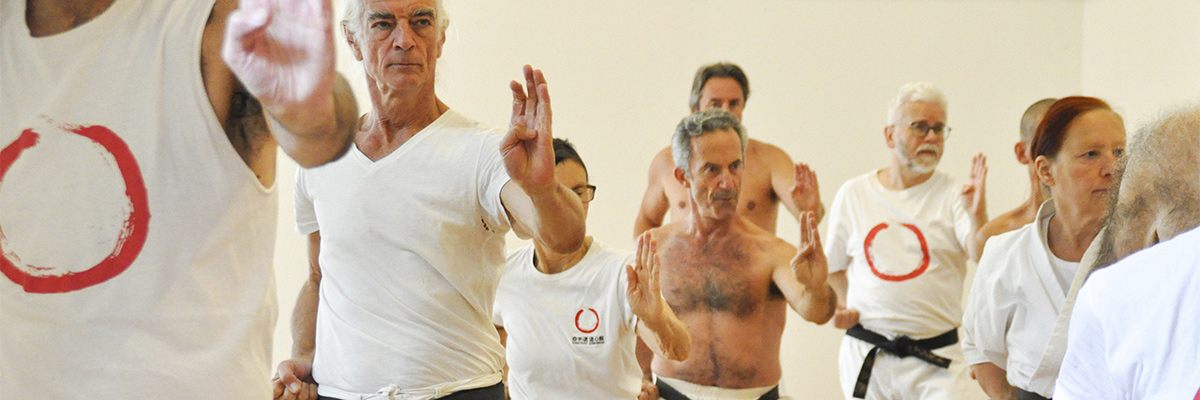Karatedo is learned through »doing«. In every moment of the training, one widens the experience of the body and its capacities. The perception and development of ki (inner energy) is as important as becoming physically skillful and strong.
Dojo
It is possible to train together with a teacher leading the group, or on one´s own as soon as one is able to do so. A »dojo« is a physical place and a group of people. It represents a space which carries the synergy of those who train. On one´s own, one can train at any undisturbed place with just a small area and time to concentrate.
Maneru – Wakaru – Nareru
Imitating – Understanding – Familiarizing
The teacher instructs the class according to the ability and needs of everyone. It is up to each student to listen to the explanation, to watch the teacher and oneself. The best spiritual attitude for beginner and advanced student is that of a blank sheet: fresh attention and openess that is not stifiled by one´s preconceptions.
Mood of training
The class is held in silence with the exception of the teacher’s explanations and the student’s participation with counting. Breath, steps, jumping and rolling are executed in a manner that produces as little sound as possible. If the soul remains tranquil and relaxed, even during the performance of fast and exhausting movements, karatedo can become a type of “moving meditation”. Only the counting, by which a student creates the rhythm of movement for the whole group, is loud. This action allows the voice to sound vigorously, as seldom is possible in everyday-life.
Themes and Class Content
Karatedo Doshinkan is not a particular »style« that differentiates itself through specialization. Instead, it explores the entirety of a martial art. The structure of classes is not predetermined by a schematic order, but by a thematic focus. Themes are numerous, and may develop over a period of time. The content of each class is different, but mental and physical energy as well as breath are in constant development.
Kata
Karatedo Doshinkan has an exceptionally rich tradition of kata. Kata (»form«) is a fixed sequence of movements. It is a central means of tradition: a condenstation of knowledge, out of which single aspects can unfold in every tranining (unfold through single movements, partner exercises, etc.). Unique in rhythm and feeling of movement, each kata is like a poem of the body, the overall character of which is deepened through repetition. According to the main rule »karate ni sente nashi« – »karatedoka never attacks first« – every kata starts with a defensive movement.
Kumite (Partner Training)
Partner training is neither competition nor game. One trains single techniques, coordinating distance and timing, or supporting each other in general exercises. One learns to adjust movements to a new situation with each partner while always executing proper technique.
Further Characteristics of Training
Further characteristics of Karatedo Doshinkan are: training with traditional weapons (bo, tonfa, sai, kama, etc) that promotes skill and body control; throwing techniques (as a defense to throw an attacker); and rolling techniques to prevent injuries when falling unintentionally or intentionally in training. A karatedoka learns to move on the floor in various ways, making »friends« with different surfaces that include wood, mat, sand and grass. One trains under all weather conditions such as sun, rain, wind, etc.
Levels of Training
Advanced students attend all levels of classes because even the simplest techniques must be continuously improved. The advanced classes are only more complex in content. For beginners, this system implies that they train from the very start in an open group. Because of this they are able to profit from the energy and experience of all, instead of being simply surrounded by beginners.
